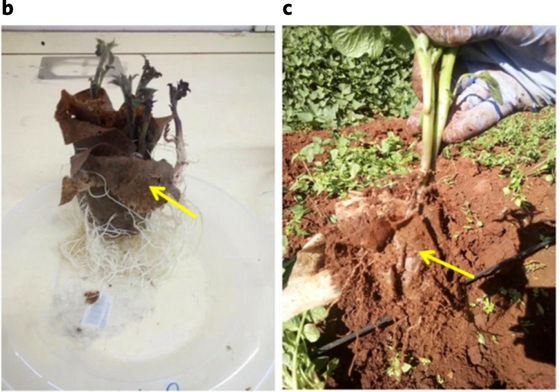Research results show that potato yields have increased five-fold with 'banana fiber bags'

Research results have been announced that '
Wrap-and-plant technology to manage sustainably potato cyst nematodes in East Africa | Nature Sustainability
https://www.nature.com/articles/s41893-022-00852-5
Potato farmers conquer a devastating worm—with paper made from bananas | Science | AAAS
https://www.science.org/content/article/potato-farmers-conquer-devastating-worm-paper-made-bananas
Potato cyst nematode is a type of nematode that parasitizes solanaceous plants such as tomatoes, potatoes, and tomatoes, and the genus Goosefoot such as quinoa . The form of ' cyst ' that changes after death of a pregnant female has drug resistance, drought resistance, cold resistance, etc., and the eggs protected in the cyst can maintain a dormant state for more than 10 years until the appearance of parasitic plants. It has been.
Outbreak situation and response of potato cyst nematodes in Hokkaido | Agriculture and Livestock Industries Corporation
https://www.alic.go.jp/joho-d/joho08_000587.html
Even in Japan, damage to potato cyst nematodes is confirmed every year in Hokkaido, where potato production is high, but potato cyst nematodes are particularly violent in developing countries in the tropics . In rich countries, there are countermeasures called pesticides, but in poor developing countries, pesticides cannot be relied on, and in countries that are cooler than temperate zones, 'potato varieties resistant to potato cyst nematodes' are tropical. Cannot be cultivated. Crop rotation is one of the effective means, but there are also circumstances in which small-scale farmers who make a living from potatoes do not want to grow crops with a lower rate of return than potatoes.
For African farmers suffering from potato cyst nematodes, the method of 'putting seed potatoes in a banana fiber bag before planting' was devised by the International Institute of Tropical Agriculture and International Insect Physiological and Ecological Research. A joint research team at Center North Carolina State University. For many years, 'when plant seeds are planted after being placed in a bag of porous fiber containing chemicals that are effective against pests, the porous fiber slowly releases the active ingredient over several weeks, and in addition, The research team, which has been working on the method of 'when the seeds germinate and become in a state where they are naturally decomposed when they have sufficient resistance to pests and do not inhibit their growth,' has tried various porous fibers such as bananas. We have found that the 'banana fiber' that can be obtained from the branches of the tree is the best.
The state of the experiment looks like this. Put the seed potatoes in a bag made of banana tree fiber and plant them as they are.

This bag protects the seed potatoes well during fragile periods such as immediately after germination, but after a few weeks when it becomes resistant to pests, it is naturally decomposed and does not inhibit growth. Therefore, once planted, it does not take time and effort.

In an experiment conducted in a field in Kenya where potato cyst nematodes were infested, the yield was tripled with a bag compared to without a bag of banana fiber, which is an effective pesticide for potato cyst nematodes. Infusing the bag with only 1 / 5,000 of the amount of abamectin sprayed on the soil further increased the yield by 50%. In addition to potatoes, experiments using other tuber crops such as yams and sweet potatoes have also yielded promising results.
Bananas are cultivated in and around Kenya, and the banana fiber used as the raw material for this bag is being discarded as waste. Therefore, banana fiber bags can be mass-produced at low cost, and the farming method itself is easy to put in the bag, so it is promising in small-scale agricultural land where mechanized agriculture has not been introduced. 'The biggest challenge is to convince farmers to try the farming method of putting them in a bag of banana fiber.'
Related Posts:







